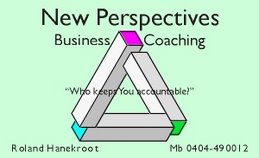Your customers, their Amygdala and Sabre-tooth tigers.
Article by Roland Hanekroot, New Perspectives Business Coaching, www.Newperspectives.com.au
There is a small almond shaped region in our brains, called the “Amygdala”. It is one of the most primitive regions deep in the base of our brains. As business owners we need to get intimately acquainted with this lump of cells in your clients brain, and how it affects her decision making processes. It is your clients’ Amygdala, more than anything else that decides if she is going to become your customer.
One of the functions of the Amygdala is to scan everyone and everything it comes into contact with for threats and danger; it is constantly on the lookout for who can be trusted and who can’t. It is often referred to as part of our reptile brain and dates back to the times when survival depended on being able to assess in an instant if the figure coming towards you was about to kill you, take you food or take your family.
And ever since the days of the dinosaurs, and sabre tooth tigers, when men were men, (and just as dense as they still are), rocks were used as tools and women were dragged around by their hair, it has been performing this function for us.
The Amygdala knows that threats are constant and all around us, and so it makes instant gut level decisions, and then goes on to scan for the next threat.
How does the Amygdala connect to your business?
The Amygdala is very powerful; it has the power to override pretty much all other functions of the brain, instantaneously.
So when a potential customer has an interaction with you, his Amygdala does its thing, and comes back with a very quick decision: friend or foe. Once it has made this decision it sends signals out to the rest of the brain to become more or less guarded.
If the signal is positive, other parts of the brain, slightly higher up are activated to start looking for more positives. And here is the thing: this whole process takes place entirely at an unconscious level. The client has no idea that all of this turmoil is taking place deep inside his brain. He won’t even start to become conscious in some way of this process for somewhere between 15 to 30 seconds. But one thing is clear: The essential decision to buy from you or not is made in that timeframe (except that he doesn’t know it yet).
Pain and pleasure
When I say that the client has made the unconscious decision to become your customer, I am not talking about a decision in the way that we normally think of a decision. The word “decision” implies a conscious process. What it really means is that the client in her whole being has decided that you are safe, and a friend, and that either a pleasure will be gained from being with you or a pain will be relieved.
This is a very good feeling for the client. When she gets this feeling she starts looking for ways and reasons (or excuses) to prolong it. And the most obvious way to prolong this feeling is to do business with you. (Remember, we are still very much at the mercy of our primitive emotions, it is a scary world outside the cave, we crave this feeling of safety constantly and we are social beings, safety in numbers)
Confusion
But keep in mind that the client doesn’t actually know that this is what he is doing and what his primitive brain is leading him to, and hence it is very easy to confuse the client at this stage. As soon as he receives a message that doesn’t fit with his first primitive assessment of you, his brain will start to go around in circles, a bit like a computer that responds to some input with an error message “Does not compute”.
We don’t have to be neuroscientists to understand that a client in this confused state is not going to buy anything. A confused client will focus on getting “un-confused” instead. Being confused puts the Amygdala back in a heightened state of arousal again, and while that goes on, buying decisions simply won’t be made.
That is the story of: The customer,
The Amygdala and Sabre-tooth tigers
Awareness of this principle has many consequences for how we as business owners should approach our marketing. I believe the following 5 steps are the first ones to focus on:
1) Be absolutely clear in your own mind what pain it is that you relieve or what pleasure you give your customers.
2) Be clear in your own mind what the promise is that you make to your customers
3) Decide what basic emotions you want to evoke in the depths of your clients brain (safety, confidence, relief etc.)
4) Live and breathe the qualities that are most likely to evoke those emotions – the first 30 seconds - (what you say, what you ask, how you look, your handshake, your confidence, it is all about your clarity and passion)
5) Explain your promise to the client and confirm the emotions you evoked in the first 30 seconds (this is about all the subsequent messages you send, your email, your website, your documents, the graphics, your logo, your voicemail message, every bit of information you give to the client will all be evaluated against her need to confirm her initial emotional assessment of you)
These steps will lead to clients becoming customers over and over.
Customers become advocates
From here of course the real work of your business starts. Now it is all about delivering on the promise you made to the client in the first place. If your business delivers on the promises you make, time after time, without fail, new customers will continue to do business with you for a very long time. Better yet, by delivering on your promise without fail, customers will become your advocates to everyone they know and meet. And when that happens, those first 30 seconds are largely taken care of before you even come in contact with clients. Your customer/advocate will already have put the clients’ Amygdalas at ease and they will be looking to confirm their decision right from the first moment they shake your hand.
I would love to enter ongoing discussions about this topic, I find it fascinating. Please feel free to add some comments
Further reading:
- “Social intelligence” by Daniel Goleman
- “A Users Guide to the Brain” by John Ratey
- “The Human Mind, and how to make the most of it” by Robert Winston
- http://www.columbia.edu/~ko2132/publications.htm
- http://www.scn.ucla.edu/
- http://newperspectives.com.au/downloads/ochsner%20The%20experience%20of%20emotion.pdf
- http://newperspectives.com.au/downloads/Lieberman%20annurev.psych.pdf







